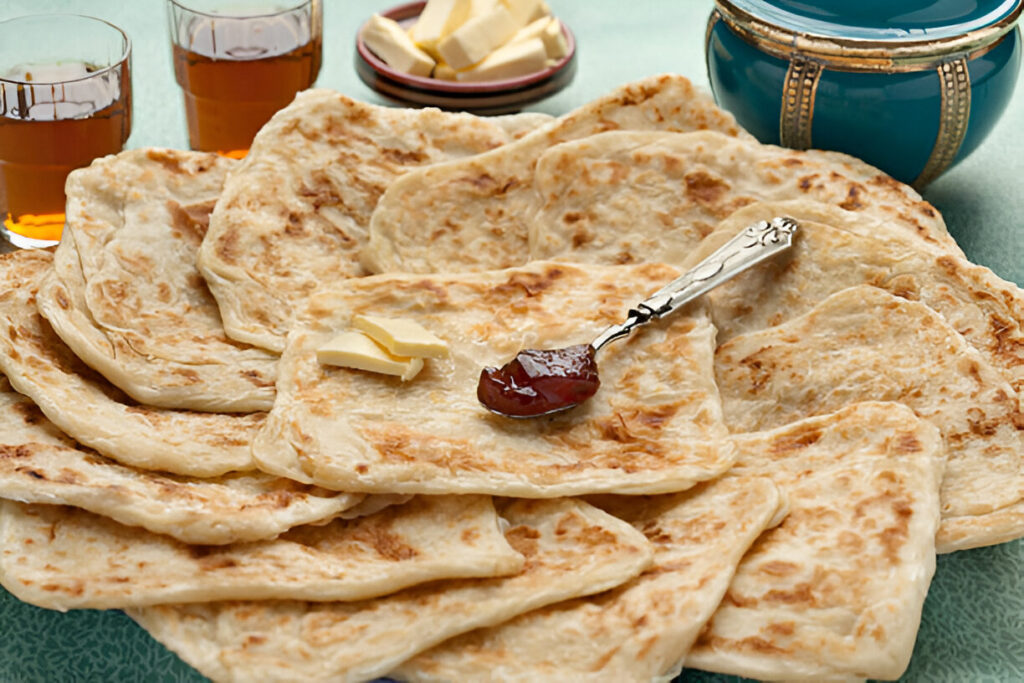
Msemen Moroccan Flatbread: The Irresistible Star of Moroccan Cuisine
Moroccan cuisine is famous for its rich flavors and varied dishes. Msemen is a standout flatbread loved by food lovers everywhere.
This traditional flatbread has layers of dough, a crispy outside, and a soft inside. It’s often filled with different ingredients or toppings. Its flexibility makes it a favorite in Moroccan meals, perfect for any time.
As we delve into Moroccan cuisine, Msemen shines as a must-try dish. Its special taste and texture bring Morocco’s true flavors to your plate.
The Rich Heritage of Moroccan Bread Culture
In Morocco, bread is more than food; it’s a sign of welcome and togetherness. The bread culture is deeply tied to the country’s history and traditions. It’s a key part of daily life and social events.
Moroccan bread, or “Khobz,” is made from flour, water, yeast, and salt. But its importance goes beyond its ingredients. It brings people together, often at the heart of meals and gatherings. Each region has its own way of making bread, passed down through generations.
Traditional Bread Making is an art that needs patience, skill, and practice. It involves mixing, kneading, and baking, often together. This makes social bonds stronger and keeps cultural heritage alive.
The cultural significance of bread in Morocco is seen at celebrations and ceremonies. Whether it’s a wedding, a religious holiday, or a family get-together, bread is always there. Breaking bread symbolizes unity, peace, and hospitality.
Moroccan bread culture is about community, tradition, and warmth. As we learn about Msemen, a Moroccan flatbread, we see the rich heritage and cultural context it’s part of.
The love for bread in Moroccan culture shows the country’s rich culinary history. As we explore Msemen, we’ll see how it fits into Moroccan bread culture.
What Makes Msemen a Unique Flatbread
Msemen is special because of how it’s made, what goes into it, and its role in Moroccan food. This traditional flatbread shows Morocco’s rich food history. Its layered dough and rich fillings make it stand out.
Making Msemen is hard work. It involves making thin dough layers, folding them, and cooking them on a griddle. This layering process makes Msemen crispy yet soft.
Ingredients are key to Msemen’s taste. It’s made with fine semolina flour, water, and salt for the dough. Fillings can be simple, like olive oil and spices, or more complex, with meat, onions, and herbs.
Msemen is very important in Moroccan food culture. It’s served at big events and is a common food in many homes. It’s eaten in many ways, from main dishes to snacks, making it even more special.
Msemen is also very versatile. You can top it with many things, from traditional honey and butter to new flavors. This makes it loved by people of all ages and tastes.
To sum up, Msemen is unique because of its detailed making process, rich ingredients, and deep cultural importance in Moroccan food. It’s a true symbol of Moroccan flatbread making, enjoyed in both traditional and modern ways.
Essential Ingredients for Authentic Msemen
To make Msemen like it’s from Morocco, you need to know the key ingredients. These ingredients give Msemen its unique taste and texture. It’s all about using simple, high-quality ingredients.
The dough for Msemen is made from fine semolina flour, also called “sooji” or “semolina.” This flour is key for the right texture. Unlike other flatbreads, Msemen uses semolina flour for its coarser texture.
To make the dough, you also need warm water and a bit of salt. The water should be warm. This helps the flour’s gluten to make the dough easier to roll out thinly.
The Moroccan spices are also crucial. They include cumin, coriander, and sometimes cinnamon. These spices are not just for flavor. They’re a big part of Msemen’s traditional taste. For the best flavor, use freshly ground spices.
To get Msemen’s layered look, brush the dough with clarified butter (or “ghee”) and oil. This adds flavor and makes the dough flaky and tender.
Some recipes add onions, herbs, or spices to the filling. But the traditional version sticks to the dough and semolina flour.
By using these essential ingredients, you can make a real Msemen. It will taste like it’s from Morocco.
Tools and Equipment for Making Msemen
To make authentic Msemen, you need the right Msemen cooking tools and equipment. Traditionally, people use a cast-iron griddle or a taj, a Moroccan clay pot. This is because it has a flat bottom.
But, you can also make Msemen in a modern kitchen. Use a non-stick skillet or a cast-iron pan. It’s important to have a surface that spreads heat evenly. This helps the Msemen cook the same all over.
You’ll also need some other kitchen equipment. A big mixing bowl is key for mixing the dough. A dough scraper or pastry cutter is handy for working with the dough.
A mezra or wooden rolling pin is used to roll out the dough. Some people like using marble or granite for this. These materials stay cool, keeping the dough fresh.
You’ll also need a sharp knife or pastry cutter for cutting the Msemen. And a spatula is useful for handling the bread while it cooks.
Step-by-Step Msemen Preparation Guide
Making Msemen from scratch is a rewarding journey. It blends tradition with creativity in the kitchen. The first step is preparing the dough, which is key to the layers that follow.
Start by mixing 2 cups of all-purpose flour, 1/2 teaspoon of salt, and 1/4 teaspoon of sugar in a big bowl. Add 1 cup of warm water and 1 tablespoon of vegetable oil. Mix until a dough forms. Knead for 10 minutes until it’s smooth and elastic. Let it rest for 30 minutes to relax the gluten.
Creating the Perfect Square Shape
To get the square shape of Msemen, roll out the dough thinly and fold it precisely. Divide the rested dough into 4 equal pieces. Roll each into a thin circle. Brush with melted butter and oil, then fold into a square, creating layers.
Getting the square shape right takes practice. The layers must be even and folds precise. Don’t worry if it takes a few tries to get it right.
Techniques for Flaky Layers
To get flaky layers, balance the dough’s thickness with the butter or oil. Brush each layer lightly but evenly with the butter-oil mix. This prevents the dough from getting too greasy.
When layering and folding, handle the dough gently. This avoids toughening the Msemen. The layers should be distinct and flaky, a sign of well-made Msemen.
Cook the Msemen on a hot griddle or skillet. Use medium heat for 2-3 minutes on each side. It should be golden brown and the layers should show. Serve hot, with your favorite fillings or toppings.
Making Msemen can be a fun experience with practice and patience. This guide helps you master this traditional Moroccan flatbread. It lets you bring a taste of Morocco into your kitchen.
Serving and Enjoying Msemen
Enjoying Msemen is a treat, whether you’re in Morocco or cooking at home. It’s a mix of tradition and flexibility. Msemen’s rich flavors and texture make it a favorite in Moroccan cuisine.
In Morocco, Msemen is often served with hot tea for breakfast or as a snack. The tea’s sweetness balances the savory Msemen, making for a great taste.
You can also pair Msemen with savory stews or fill it with meats, veggies, cheeses, and herbs. Its versatility makes it perfect for daily meals and special events.
Msemen is also used in modern dishes, mixing Moroccan flavors with international ones. It can be a pizza base or a wrap for unique fillings, adding a twist to classic dishes.
How you present Msemen is key. Add fresh herbs, serve with preserved lemons, or drizzle with sauce. This enhances the meal. The goal is to mix flavors and textures well.
Msemen’s flexibility and taste make it a great addition to any meal. Whether sticking to Moroccan traditions or trying new recipes, Msemen’s enjoyment is endless. Your creativity is the only limit.
Storing and Reheating Your Msemen
Enjoying Msemen over time depends on how you store and reheat it. Proper storage is key to keep it fresh and tasty.
To store Msemen, you can keep it at room temperature for a short time or freeze it for longer. For a short time, put Msemen in an airtight container. This keeps it fresh for up to 2 days. For longer storage, freezing is best. Wrap each Msemen in plastic wrap or foil and put them in a freezer-safe bag.
There are several ways to reheat Msemen. You can reheat it in a dry pan over medium heat for a few minutes on each side. Or, wrap it in a damp cloth and microwave for 20-30 seconds. You can also reheat it in a preheated oven at 350°F (175°C) for 5-7 minutes.
By following these simple steps, you can enjoy your Msemen at its best, even days after making it.
Finding Msemen in the United States
Moroccan food is becoming more popular in the US, with Msemen leading the way. As more international foods become available, finding real Msemen is getting easier for fans.
In big cities like New York and Los Angeles, many Moroccan restaurants now serve Msemen. They offer a true taste of Moroccan dishes. Some specialty grocery stores also sell Msemen or the ingredients to make it yourself.
For those who like to shop online, there are many places that sell Msemen or Moroccan ingredients. This makes it simple to enjoy Msemen at home. The growing interest in international food has made it simpler to find and enjoy Msemen in the US.
Bringing Moroccan Flavors to Your American Kitchen
Moroccan flavors can make your cooking in the American kitchen special. By using international cooking methods, you can make your meals more exciting. This creates a mix of flavors that’s unique.
Try using Msemen as a base for different toppings or fillings. You can also pair it with Moroccan dishes like tagines or salads. Msemen is great for any meal, from a quick snack to a full dinner.
Adding Moroccan flavors to your cooking can lead you to try other international cuisines. This opens up a world of new tastes for you and your loved ones. Start with Msemen and explore the rich flavors of Moroccan cuisine right in your American kitchen.










